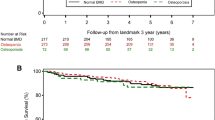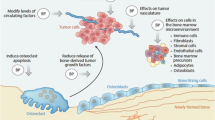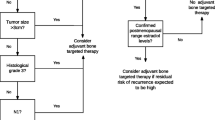Abstract
Bisphosphonates are the most commonly used agents in the treatment of osteoporosis, and bisphosphonate therapy reduces the risk of skeletally related complications in patients with bone metastases due to malignancy. However, the effect of oral alendronate treatment on clinical and pathological properties of breast cancer has not been reported. Thus, we aimed to investigate retrospectively the demographic and clinico-pathological characteristics of new diagnosis of breast cancer patients with oral alendronate users for longer than 1 year, compared with non-users. Newly diagnosed breast cancer patients from 1998 to 2010 in our clinic were retrospectively analyzed. Patient’s demographics, including survival data and tumor characteristics, were obtained from medical charts. Breast cancer patients who were taking oral alendronate more than 12 months at the time of breast cancer diagnosis were enrolled as an alendronate users (n = 44), where the patients matched with the same age who were not taking oral alendronate were included as a control group (n = 444). A total of 488 patients were included in this study. Forty-four patients received an oral alendronate treatment more than 1 year, and 444 patients were considered as non-users. Median age of both alendronate users and non-users was 57 (33–89). Lower incidence of histological grade III, T3–T4 tumor, and node positivity was seen in alendronate users but not statistically significant. A similar trend for lower incidence of triple negative and higher incidence ER (P = 0.13), progesterone receptor (P = 0.12), and HER2 positivity (P = 0.21) was also seen in alendronate users but not statistically significant. Estimated median disease-free survival was 150 months in alendronate users where as 70 months in non-users (P = 0.015). Five-year survival rate in alendronate users was 97.4 %, whereas in non-users was 89.8 % (P = 0.13). The use of oral alendronate for longer than 1 year at the time of breast cancer diagnosis was associated with better clinico-pathological properties and significantly improved disease-free survival in breast cancer patients.


Similar content being viewed by others
References
Winter MC, Holen I, Coleman RE. Exploring the anti-tumour activity of bisphosphonates in early breast cancer. Cancer Treat Rev. 2008;34(5):453–75.
Santini D, Martini F, Fratto ME, Galluzzo S, Vincenzi B, Agrati C, et al. In vivo effects of zoledronic acid on peripheral gammadelta T lymphocytes in early breast cancer patients. Cancer Immunol Immunother. 2009;58(1):31–8.
Cleton FJ, van Holten-Verzantvoort AT, Bijvoet OL. Effect of long-term bisphosphonate treatment on morbidity due to bone metastases in breast cancer patients. Recent Results Cancer Res. 1989;116:73–8.
Kanis JA, Burlet N, Cooper C, Delmas PD, Reginster JY, Borgstrom F, et al. European guidance for the diagnosis and management of osteoporosis in postmenopausal women. Osteoporos Int. 2008;19(4):399–428.
Brufsky A, Bundred N, Coleman R, Lambert-Falls R, Mena R, Hadji P, et al. Integrated analysis of zoledronic acid for prevention of aromatase inhibitor-associated bone loss in postmenopausal women with early breast cancer receiving adjuvant letrozole. Oncologist. 2008;13(5):503–14.
Gnant M, Mlineritsch B, Schippinger W, Luschin-Ebengreuth G, Postlberger S, Menzel C, et al. Endocrine therapy plus zoledronic acid in premenopausal breast cancer. N Engl J Med. 2009;360(7):679–91.
Eidtmann H, de Boer R, Bundred N, Llombart-Cussac A, Davidson N, Neven P, et al. Efficacy of zoledronic acid in postmenopausal women with early breast cancer receiving adjuvant letrozole: 36-month results of the ZO-FAST study. Ann Oncol. 2010;21(11):2188–94.
Diel IJ, Jaschke A, Solomayer EF, Gollan C, Bastert G, Sohn C, et al. Adjuvant oral clodronate improves the overall survival of primary breast cancer patients with micrometastases to the bone marrow: a long-term follow-up. Ann Oncol. 2008;19(12):2007–11.
Saarto T, Blomqvist C, Virkkunen P, Elomaa I. Adjuvant clodronate treatment does not reduce the frequency of skeletal metastases in node-positive breast cancer patients: 5-year results of a randomized controlled trial. J Clin Oncol. 2001;19(1):10–7.
Powles T, Paterson A, McCloskey E, Schein P, Scheffler B, Tidy A, et al. Reduction in bone relapse and improved survival with oral clodronate for adjuvant treatment of operable breast cancer [ISRCTN83688026]. Breast Cancer Res. 2006;8(2):R13.
Rennert G, Pinchev M, Rennert HS. Use of bisphosphonates and risk of postmenopausal breast cancer. J Clin Oncol. 2010;28(22):3577–81.
Chlebowski RT, Chen Z, Cauley JA, Anderson G, Rodabough RJ, McTiernan A, et al. Oral bisphosphonate use and breast cancer incidence in postmenopausal women. J Clin Oncol. 2010;28(22):3582–90.
Coleman RE, Winter MC, Cameron D, Bell R, Dodwell D, Keane MM, et al. The effects of adding zoledronic acid to neoadjuvant chemotherapy on tumour response: exploratory evidence for direct anti-tumour activity in breast cancer. Br J Cancer. 2010;102(7):1099–105.
Saarto T, Vehmanen L, Virkkunen P, Blomqvist C. 10-year follow-up of a randomized controlled trial of adjuvant clodronate treatment in node-positive breast cancer patients. Acta Oncol. 2004;43(7):650–6.
Powles T, Paterson S, Kanis JA, McCloskey E, Ashley S, Tidy A, et al. Randomized, placebo-controlled trial of clodronate in patients with primary operable breast cancer. J Clin Oncol. 2002;20(15):3219–24.
Diel IJ, Solomayer EF, Costa SD, Gollan C, Goerner R, Wallwiener D, et al. Reduction in new metastases in breast cancer with adjuvant clodronate treatment. N Engl J Med. 1998;339(6):357–63.
Kristensen B, Ejlertsen B, Mouridsen HT, Jensen MB, Andersen J, Bjerregaard B, et al. Bisphosphonate treatment in primary breast cancer: results from a randomised comparison of oral pamidronate versus no pamidronate in patients with primary breast cancer. Acta Oncol. 2008;47(4):740–6.
Stahlberg C, Pedersen AT, Andersen ZJ, Keiding N, Hundrup YA, Obel EB, et al. Breast cancer with different prognostic characteristics developing in Danish women using hormone replacement therapy. Br J Cancer. 2004;91(4):644–50.
Borgquist S, Anagnostaki L, Jirstrom K, Landberg G, Manjer J. Breast tumours following combined hormone replacement therapy express favourable prognostic factors. Int J Cancer. 2007;120(10):2202–7.
Chlebowski RT. Vitamin Dand breast cancer: interpreting current evidence. Breast Cancer Res. 2011;13(4):217.
Conflict of interest
The authors indicated no potential conflicts of interest.
Author information
Authors and Affiliations
Corresponding author
Rights and permissions
About this article
Cite this article
Şendur, M.A.N., Aksoy, S., Yaman, Ş. et al. Demographic and clinico-pathological characteristics of breast cancer patients with history of oral alendronate use. Med Oncol 29, 2601–2605 (2012). https://doi.org/10.1007/s12032-012-0209-9
Received:
Accepted:
Published:
Issue Date:
DOI: https://doi.org/10.1007/s12032-012-0209-9




